
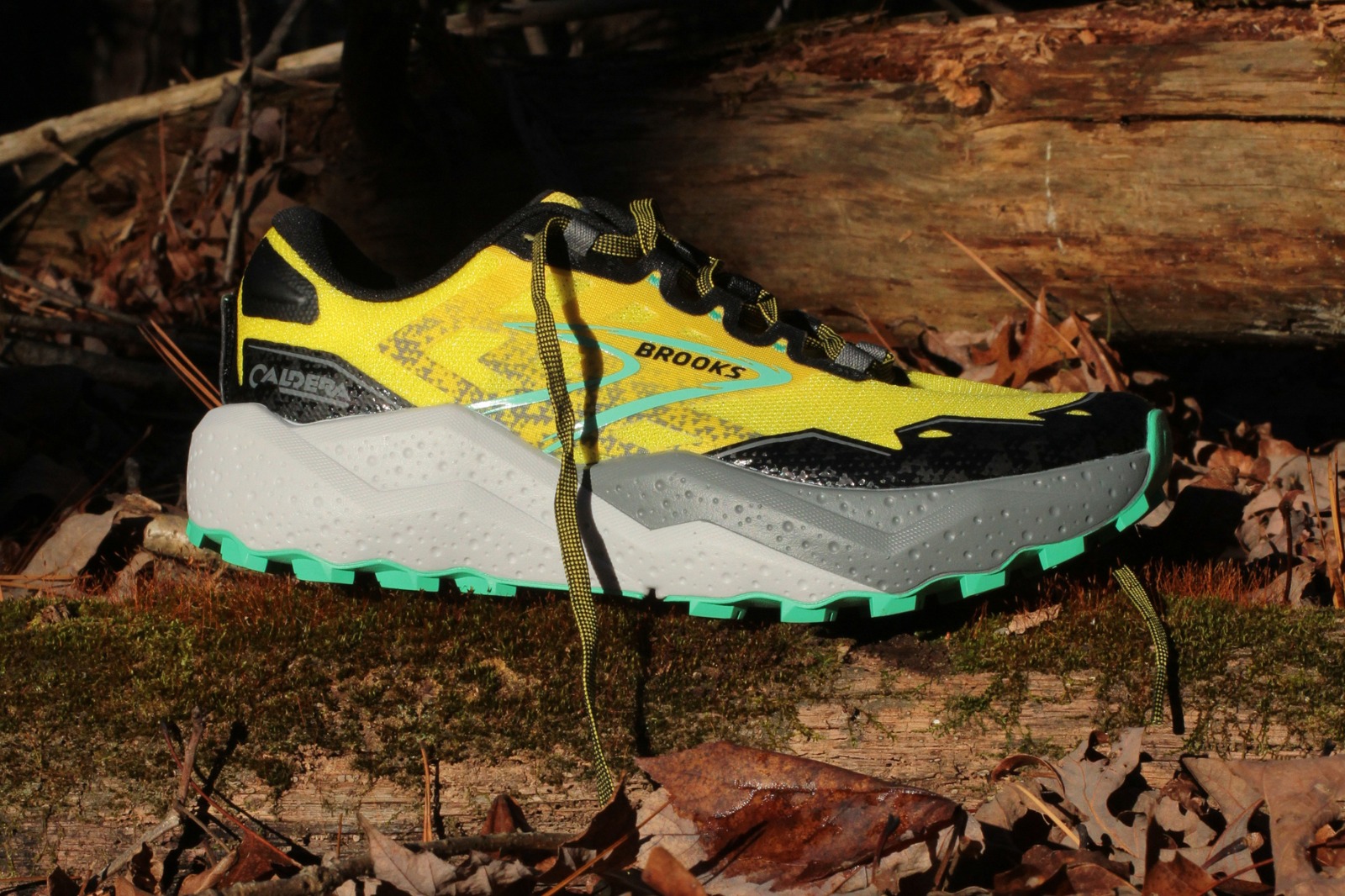
We independently review everything we recommend. When you buy through our links, we may earn a commission.
10.6 oz (300 g) for a US M9,
9.4 oz. (266 g) for a US W8
26 mm in heel, 20 mm in forefoot (6 mm drop), midsole only
Long distances over easy to slightly technical terrain
TPEE Air Mesh upper, TrailTack Green outsole with 4 mm lugs, DNA Loft v3 supercritical midsole, bathtub-style construction
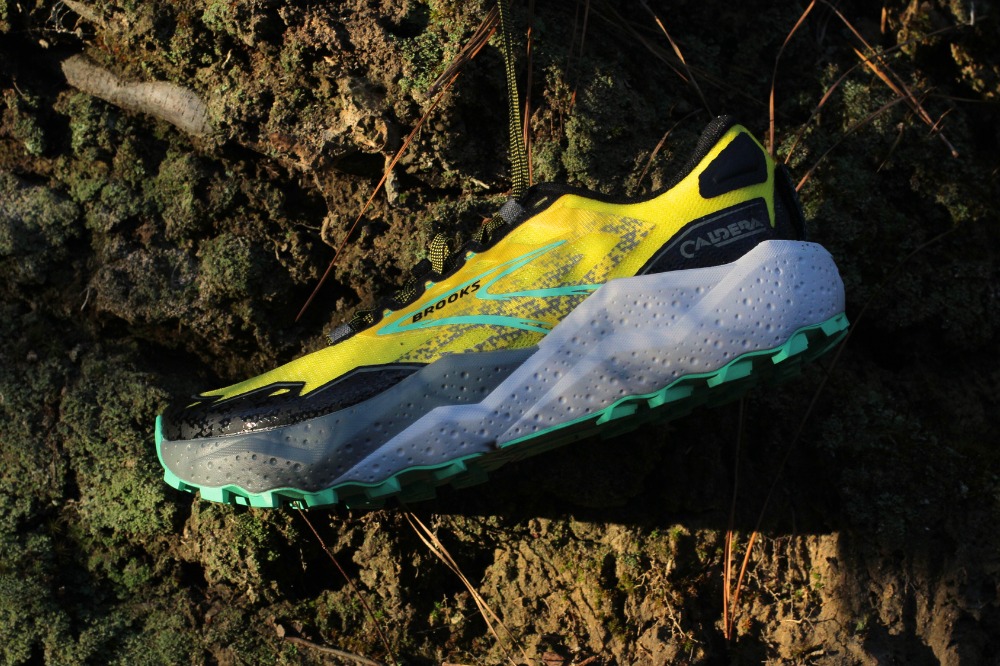
Mountain range sidewall design is a nice touch
TAYLOR: As the pre-dawn thermometer currently reads a balmy -12F degrees here in Colorado, I wrestle with the idea of nixing today’s run altogether. It’s hard not to dream about summer days ahead and the winding singletrack through valleys and over peaks. In my current state, I’m thinking of the shoe we’re talking about today, the Brooks Caldera 7. You’ll find out why in a second.
Contrary to many runners’ first experience in a high-stack shoe, Hoka was not my first. It was the Brooks Caldera 4. A long haul shoe, it’s changed over the years. The last version, the Caldera 6, took on a wildly different design with an even higher stack, a bulging and bouncy supercritical midsole, and a footprint that could easily be mistaken as Bigfoot’s.
After thoroughly enjoying both designs in the Caldera history, I found myself wishing they could merge. In some ways, that’s what we have in the Brooks Caldera 7. It maintains a DNA Loft v3 midsole, moderately aggressive TrailTack outsole, and bathtub footbed design. However, Brooks pulled out the shears and slashed a couple millimeters off of the overall stack, a little bit of edging occurred in the outsole, and a brand new sleek TPEE upper was added. If done right, all these subtle updates have the potential to add up in a big way.
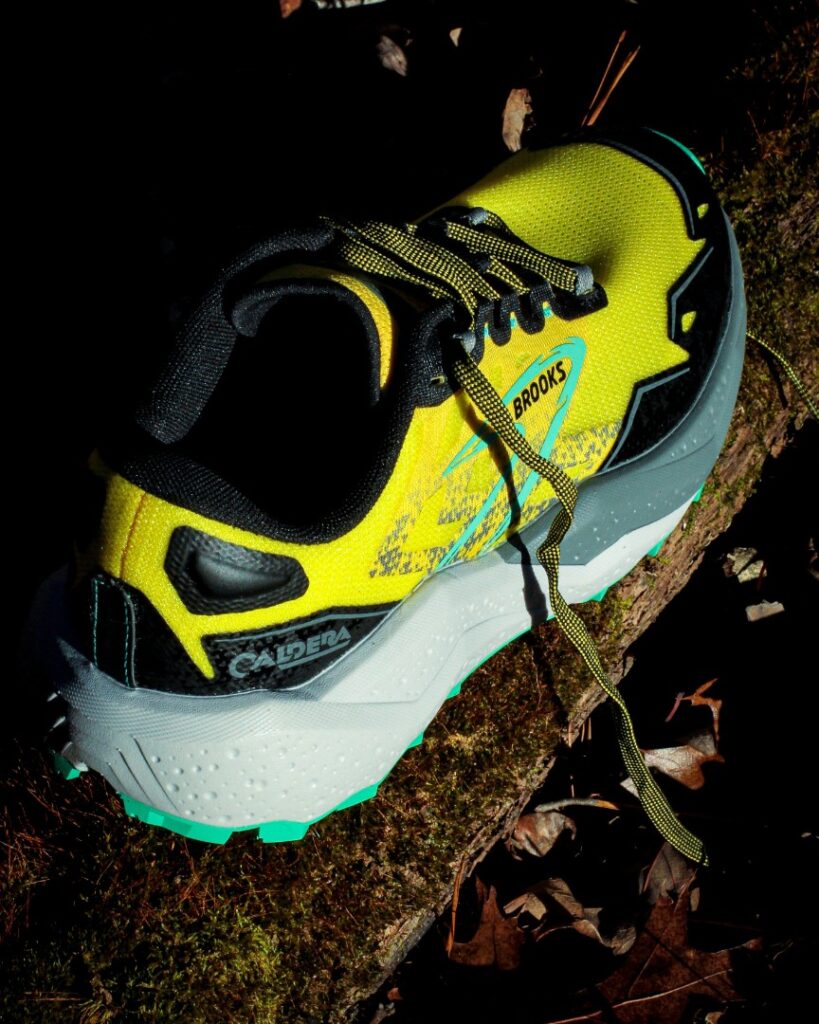
Upper is protective and drains well
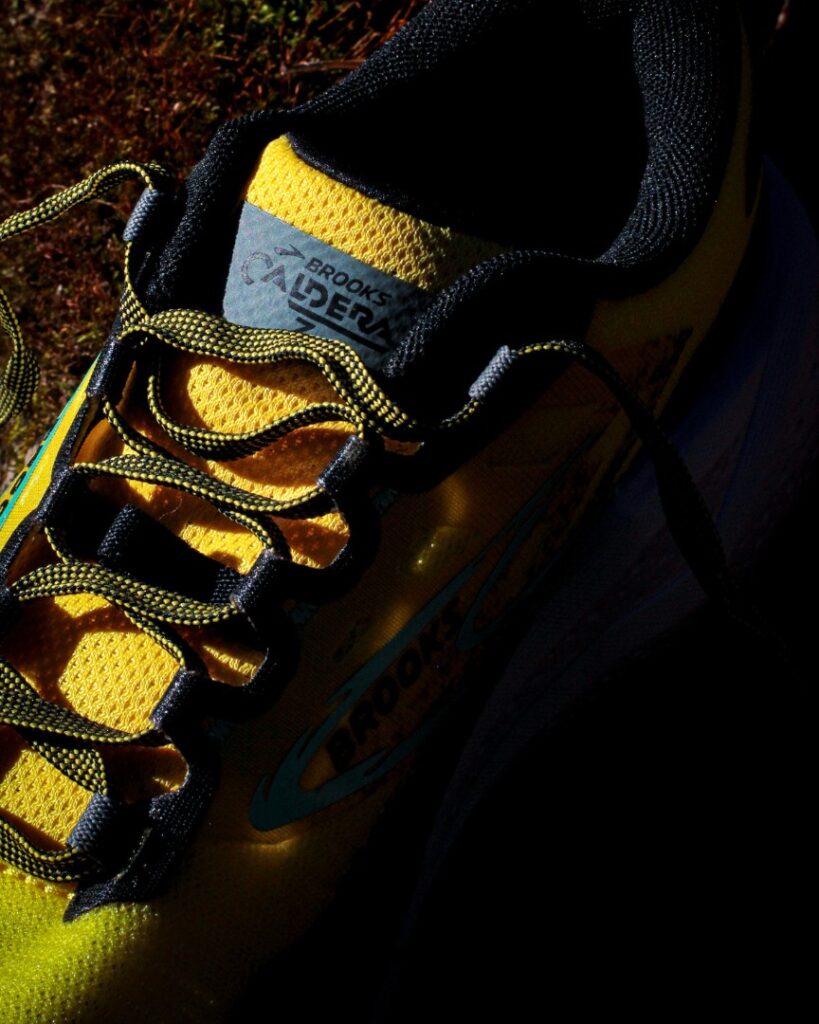
Laces provide a solid lockdown
ROBBE: I don’t run trails as much as the other three guys on this review, but I get them in when I can, which is usually when I’m training for the Maryland-based HAT 50K trail race in March. It was at the 2022 version of that race that I snagged a PR in the distance wearing the Brooks Caldera 6. A monster truck of a shoe, it rolled over everything while handling varied trail terrain and roads equally well.
Brooks took the positives from that shoe and tweaked them to make the Caldera 7, which I just wore for a fatass 50K last weekend at the Patapsco Party 50K. The route was a point-to-point mix of roads and trails starting at the top of Patapsco State Park and winding southwards before ending at the Guinness Brewery in Halethorpe. In short, it was the perfect testing grounds for the shoe.
JOHN: The day I got the Caldera 7 in the mail, I was headed to see Wonka with my daughter. Afterward, I was in a pure imagination candy world which may have influenced this review. In order to fully test the Caldera 7, I took the shoe to the rugged Massanutten Mountains for the Boyer’s Furnace 40-mile trail run with The Virginia Happy Trails Running Club.
What immediately jumped out at me was the updated stability features this shoe offers and the cotton candy-like soft foam. It’s deliciously comfortable. On paper this shoe is like a magical candy recipe, sure to strike fear into the chocolate cartel.
So is the Caldera 7 a legendary Gene Wilder? Is it the unnecessary appearance of Johnny Depp with few redeeming qualities? Or is it a twee mastermind in the spirit of Timothée Chalamet?? Let’s travel into a world of pure imagination and find out.
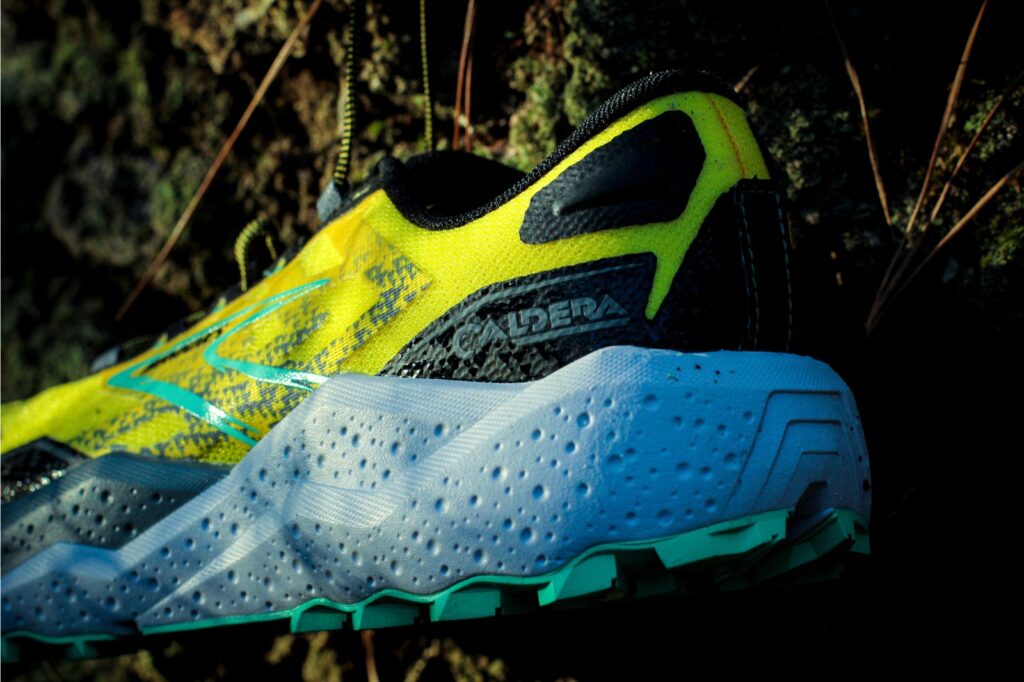
DNA Loft v3 midsole
MICHAEL: While John ventures into a wild Willy Wonka wonderland, I’m going to take a trip back to the year 2022. At the time, I was living with my buddies in an old, broken-down house with two kitchens. It was in the second kitchen of this humble abode whence arrived my first shoe from BITR, the Brooks Caldera 6.
Of course, the shoe was great, and after the review, I kept coming back to it again and again for easy miles on technical terrain. Between the maxed-out chunk of DNA Loft v3 foam, a capable outsole, and some inherent stability, it was the perfect shoe for long, easy miles over technical terrain. Since then, I’ve put a modest 200 miles on version 6 in between reviewing other shoes, and the ride of the Caldera is just as lovely as it was on day one (albeit with lots of dirt stains).
Not much has changed since version six, but steady refinements like a drop in weight, a better-fitting upper, and an even more rugged, capable outsole (making an already good outsole great) are bound to bring improvements to a model already loved by our crew here at BITR. Let’s get to it!
TAYLOR: As a shoe reviewer, these are the updates we live for. Overhauls are fun and all, but the incremental refinements are what I love most.
Like Michael, even after my testing was complete, I kept putting on miles in the previous version. Overall, this shoe lost some weight (almost an ounce) and gained control. Even though it’s the same foam, some intentional cuts were also made into the outsole to resemble a mountain goat’s hoof, giving this ride a little more flex than the previous model. These two simple changes are the difference maker. The Brooks Caldera 7 is simply easier to run in than its predecessor, and it’s noticeable right out of the box.
I’m thankful for the retention of the DNA Loft v3 midsole compound. Even with the loss of 4 mm, the Caldera 7 doesn’t sacrifice anything from the previous iteration. This type of nitrogen-infused foam is a unique blend for the trails that offers a truly responsive, smooth, and protective ride. It has a medium density with an airy squish and bounce off the toe, making for one of those carefree running experiences. It’s so unique that it’s hard to make comparisons. The Speedland SL:PGH and SL:OAK and the Asics Trabuco Max 2 are the only ones that have a similar midsole feel.
It’s also one of the few nitro midsoles that retains its integrity for a long time, allowing you to stack miles for training or racing.
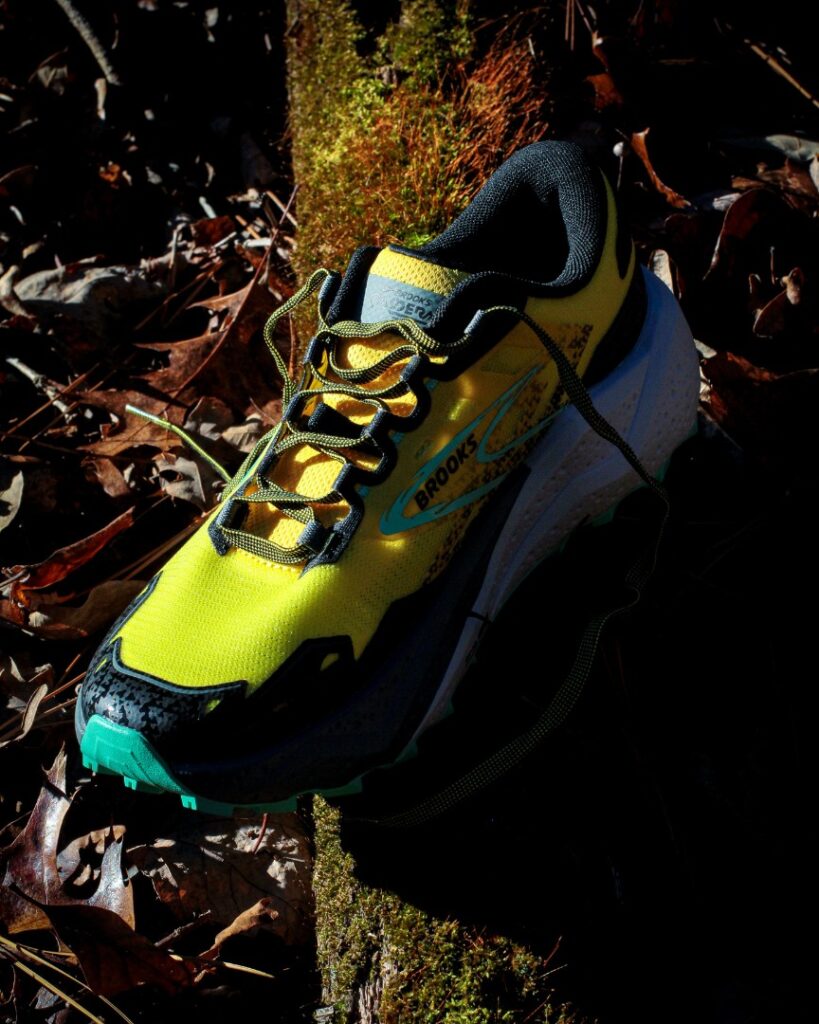

The very broad footprint of the Brooks Caldera 7 makes the ride inherently stable. One of the reasons I’ve enjoyed running in this shoe over the winter is because it feels like a small snowshoe. I feel like I’m floating over everything. Even though it’s categorized as a neutral shoe, it’s going to please all runners who want/need that extra assurance for their ankles (we’re all looking at you, Robbe). From an ultrarunner’s perspective, this shoe is made for those long day adventures and races over any terrain and will naturally reduce fatigue in the lower leg because of the stability it provides.
Underneath that wide footprint is a mostly rubber-covered outsole. The new Trailtack Green formula is still grippy and gritty and will last. Brooks has always done a solid job in the grip department and the Caldera 7 is no different. The 4 mm chevron lugs grip in a variety of conditions.
A few bare foam sections are always met with hesitation by true trail runners. I like it in this case. The grip isn’t compromised, and the cutouts allow for the shoe to be a little more flexible. I actually wish there were a few more or deeper segments of the outsole and midsole foam.
A brand new upper was a good choice here. Even though I did not have anything overly negative to say about the previous model, this TPEE dual layered upper allows for a little more flexibility and breathability. Brooks knows how to make money with their overall fit – moderately generous in forefoot with a nicely padded rear half. Because of the new upper materials/construction, foot security was great which gave a lot of confidence on everything from roads to fairly technical terrain.
I guarantee my compatriots will agree that the price is impressive on this one. For me, this Brooks Caldera 7 can pretty much go toe-to-toe with the Speedland SL:PGH and comes in at $150.
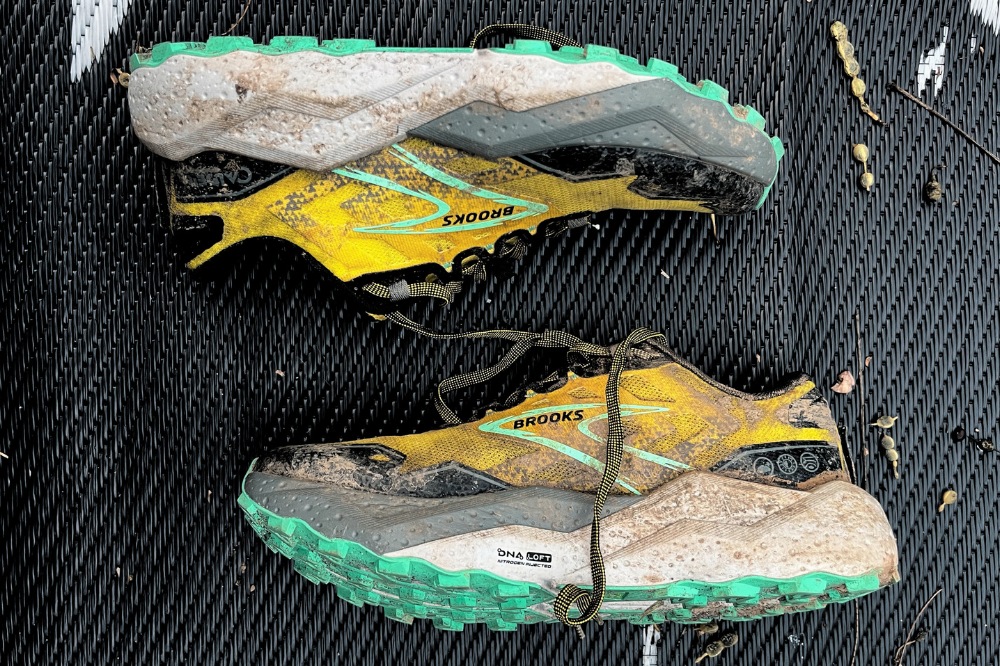
Dirtied up
ROBBE: Taylor really covered everything about the shoe, and I agree on all points. By lowering the stack height and reworking the upper, the Caldera 7 is a far more nimble shoe than the previous version. I liked the Caldera 6 for its “roll over everything” capabilities, but it felt very blocky at times. While I wouldn’t call the Caldera 7 a sleek slipper (it certainly has its blocky moments), it definitely is better at picking through rocks and roots on more technical terrain. In short, it’s just more runnable.
The upper on this version is also surprisingly breathable, but still manages to keep out dirt and debris. We were forced into a couple knee-high creek crossings, and being an already heavy shoe, I was dreading the added water weight. Surprisingly, it drained off quickly to where I didn’t notice a difference within a mile or so.
For an aggressive shoe, it handles roads nicely thanks to the supercritical DNA Loft v3 compound in the midsole. Comfortable and responsive, it allows you to pick up some extra time without an overly harsh ride.
Despite being a higher-stack shoe, it’s surprisingly stable thanks to the bathtub construction and wide platform. No issues whatsoever with stability in this shoe, which was really a nice surprise.
I wore this shoe out of the box for 33 miles without lube or blister cream on my feet and came away with zero blisters or hot spots. That’s a hallmark of achievement in my world.
JOHN: I really enjoyed the fit of the Caldera 7. It was nice and wide and fit me true to size 11.5. After spending hours shuffling, running, and walking all day over easy, medium, and extremely challenging trail, for the most part my feet felt great.
I’m not a really fashion oriented guy but this shoe is good looking, and I really enjoyed seeing the mountain range on the sides of the shoe. The upper is super breathable, keeping your feet dry from sweat and while draining water from creek crossings.
The shoe offers surprisingly great grip on the rocks. The Caldera 7 is extremely comfortable on easy and medium trails. I found it’s serviceable on tougher ones but we’ll get to that in just a minute.
At $150, this is an amazing price for everything this shoe offers.

MICHAEL: Right off the bat, Brooks fixed the main issue I had with the Caldera 6: the fit. Lacing near the forefoot cinches down, stays put, and provides some adaptable lockdown for rumbling along more technical terrain. Additionally, the upper is much more durable than the previous version’s engineered mesh while remaining supple enough for comfort. A robust toe box rounds out this refined up(per)date.
As previously mentioned, the supple ride of the Caldera 7 is deserving of significant praise, but I think where this shoe really stands out is in its wild intersection of price and durability; if you’ve got the buck, this shoe has got some serious bang. The aforementioned upper update is durable, the outsole is tough, and the midsole (basically unchanged from the previous version) has shown no signs of slowing down. I see this easily exceeding the two years and 200 miles I put in on version 6.
Lastly, I want to shine some dedicated light on the Trailtack green outsole. An updated Chevron lug configuration (basically the best lug shape ever because, you know, science) offers class-leading grip, performing admirably in wet and dry conditions alike. To me, this technical trail capability is what really sets this shoe apart from other max-cushion trainers. I love it!
Shop Brooks Caldera - Men Shop Brooks Caldera - WomenTAYLOR: The Brooks Caldera 7 is still a whole lot of shoe. Weight actually isn’t bad; it’s just the sheer size of the dang thing! My men’s 10.5 came in at 11.4 ounces.
The back half of the shoe is where the bulk of material is, clearly. I feel it on the run too. Overall, the Brooks Caldera 7 runs quite smooth; however, the more speed and angles you put into the shoe, the more the back half tries to dictate. Such construction makes for a very stable ride.
The downfall comes in the form of some resistance and sometimes a “blocky” feeling while rolling over some rocks, roots, or quick curves. You don’t even need the technical elements. Just picking up the pace will help make you feel the governance.
On a more subtle note, these toe bumpers can be rough. I felt the firmness around the pinky toes most often. Every so often, on quick descents, I could feel the front toe cap as well. I’m not typically all that sensitive to this, so it’s something worth noting.
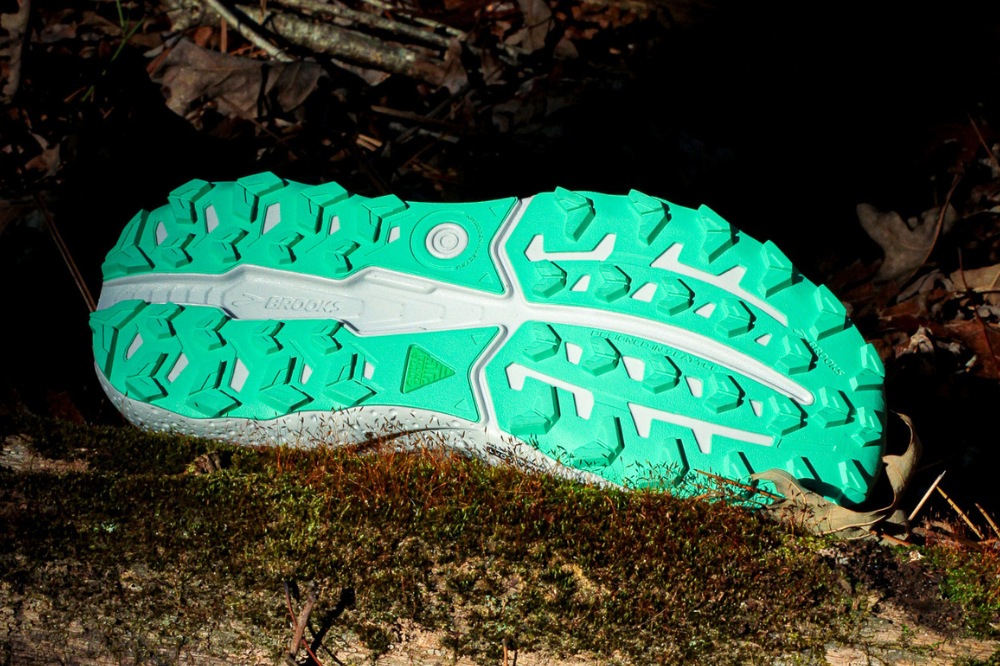
TrailTack Green outsole
ROBBE: If I had to nitpick, I’d say that it does tend to feel a little bulky/blocky, though it is improved over the previous version. I mean, it’s not a light shoe by any means. But it’s a long haul trail shoe, I’m not sure what else you want.
If you’re looking for the bounce that was found in the Caldera 6, you won’t find the same level in this one. I think it’s fine because I think it makes this a better performing trail shoe. But if you enjoyed that aspect of the previous version, you’ll find a more subdued ride here.
JOHN: The East coast rocks are like everlasting gobstoppers. During my adventure wearing the Caldera 7, I did feel the rocks and at times it wasn’t comfortable. It’s tough though because the lack of rock plate makes it comfortable on most trails but on the more technical rocky stuff, I found the shoe frustrating.
With that said, it is extremely difficult to walk the line of comfort and protection. In this case I would like more overall protection. For anyone considering using this for extremely rocky terrain, I do think it’s serviceable out there, but it works best on easy to medium trails. The arches of my feet felt a little bad from rock hopping in these all day. Again, Massanutten is a very challenging trail, so take the testing scenario into consideration.
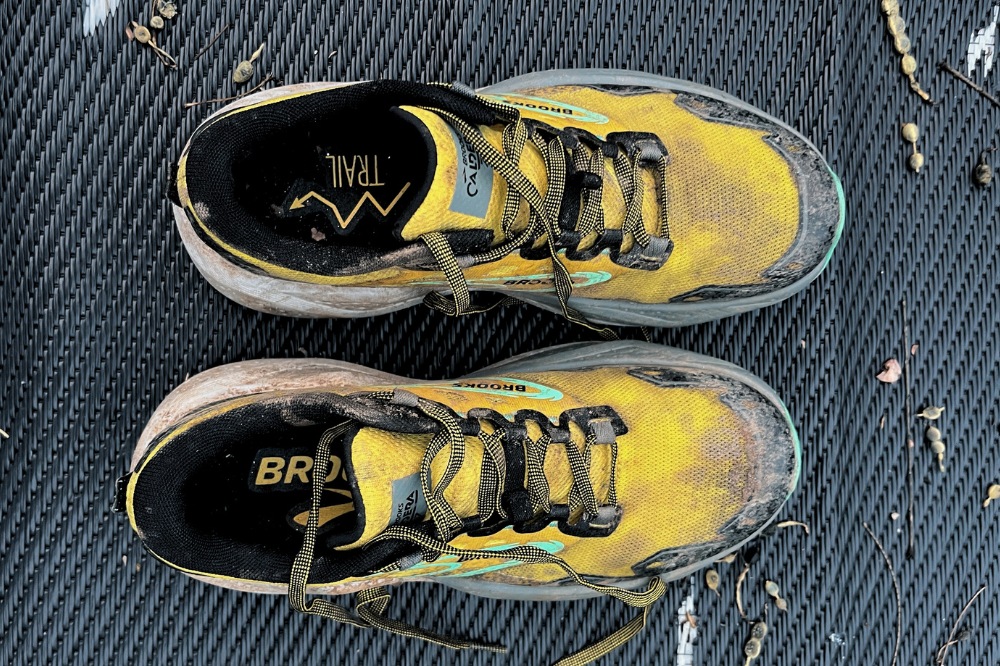
Toe bumpers provide protection
MICHAEL: Like Taylor, I think the personality of the Caldera 7 heel is two-faced. A catalyst for both stability and instability, it’s like poorly tuned car suspension; as long as you keep input parameters like bumps and road chatter mellow and mostly chill, the suspension will take that input and turn it into a dampened, stable output. Throw in a massive pothole, and the suspension will react drastically – springing and bouncing about.
The same goes for stability in the Caldera 7 heel. Keep things mostly tame, and you’ll be as sure-footed as a mountain goat. Go trancing through wild, chunky rocks and roots, and your ankles might get a little thrashed around by the ultra-wide footprint of the shoe. All that being said, you can always lean forward a bit, plant through the ball of your foot through technical terrain, and avoid large obstacles pretty easily on most trails. A little line choice goes a long way in the Southeast.
For the Caldera 7 update, flexibility was highlighted as a significant improvement to version 6. I didn’t exactly find that to be true. It’s not a big deal, as there’s enough of a rocker in this shoe that makes for a comfortable ride at chill paces. Turn up the speed, and the lack of flexibility is still pretty evident in my experience.
Shop Brooks Caldera - Men Shop Brooks Caldera - WomenTAYLOR: Honestly, this shoe may not make it in my rotation for the summer months I’m so ready to have. I may have already run too many miles by that point. The Brooks Caldera 7 comes in with an impressive update that maintained what was best in the previous version and fine tuned the rest for performance.
The Brooks Caldera 7 is going to be for the trail runner who loves a lot of protection, a fun ride, and stability to keep them going. It can get a little ornery at times, but the Caldera 7 is built to go long over and over and over again. I was surprised at the range of terrain this shoe could access with ease. Though it may not quite have the technical prowess of the Speedland SL:PGH, it is probably the closest high-stack contender. And for only $150, that’s a steal.
ROBBE: For this shoe at this price, I’m not sure what else you’re looking for. It’ll make a great shoe for any trail adventure, whether running or hiking. As much as I loved the Caldera 6, this one is even better. For a speedier and more nimble version, make sure you check out its cousin in the Catamount 3.

JOHN: So which iteration of Roald Dahl’s classic most aligns with the Caldera 7? Timothée Chalamet in Wonka. It’s fun, it’s colorful and imaginative, and for $150, a solid option for a day in the mountains. Overall I highly enjoyed the Caldera 7 as a long haul shoe! Definitely check out the recent review of the Stinson 7. That shoe doesn’t have as much sticky grip but the stable feel of the shoe and weight is very similar to the Caldera 7.
MICHAEL: Like its lightweight cousin in the Catamount, the Caldera 7 boasts an impressive amount of versatility in a durable, reasonably priced package. If you are staring down a massive training block (or race) and need a cushioned, stable, injury-averse, and capable shoe to throw mile after mile at over a wide variety of terrain, I can’t recommend the Caldera 7 enough.
You can pick up the Brooks Caldera 7 for $150 at Running Warehouse (featuring free 2-day shipping and 90-day returns) using the buttons below.
Have something to say? Leave a Comment

Taylor Bodin is a trail and ultra runner living in Estes Park, Colo., with his wife and daughters. As the head of the Dirt Division at Believe in the Run, trail running is pretty much the only hobby he can manage right now and loves it. Every so often, he will pop off a race or FKT attempt because competition is pure and the original motivator for him getting into running anyway.
More from Taylor
Robbe is the senior editor of Believe in the Run. He loves going on weird routes through Baltimore, finding trash on the ground, and running with the Faster Bastards. At home in the city, but country at heart. Loves his two boys more than anything. Has the weakest ankles in the game.
More from Robbe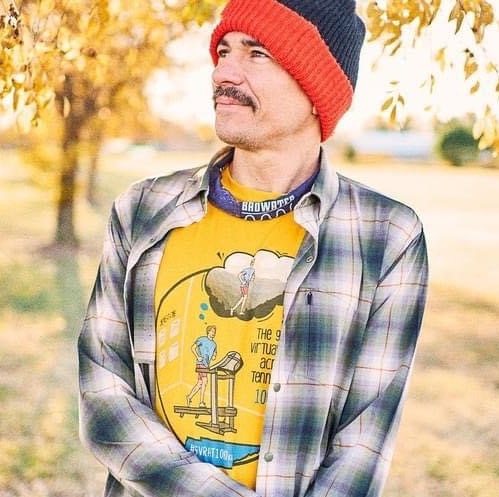
An obsessed runner, John has run in most ultra races in the Mid-Atlantic area. Since he’s an ultra runner, it’s no surprise he’s also a lover of food. He’s also a dedicated father, caregiver, and veteran.
More from John
An engineer living with his wife and cat in Birmingham, Ala., Michael loves chill morning runs in the neighborhood, but especially enjoys soaking up long miles of technical southeast singletrack. Occasionally, he’ll get a racing itch and actually string together some “organized” training for a trail race or FKT. In his free time, Michael enjoys books, backpacking, and hanging out with friends.
More from Michael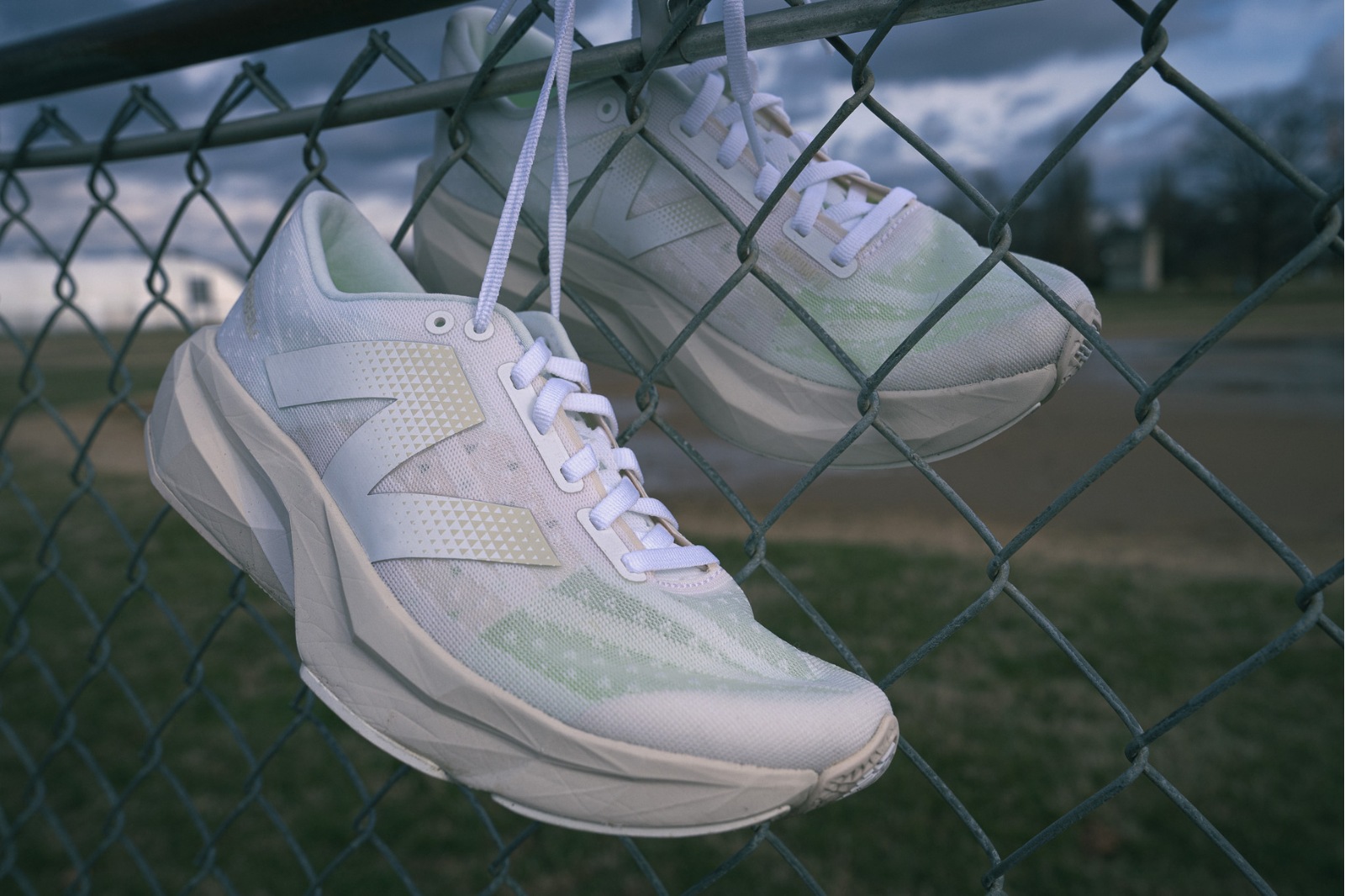
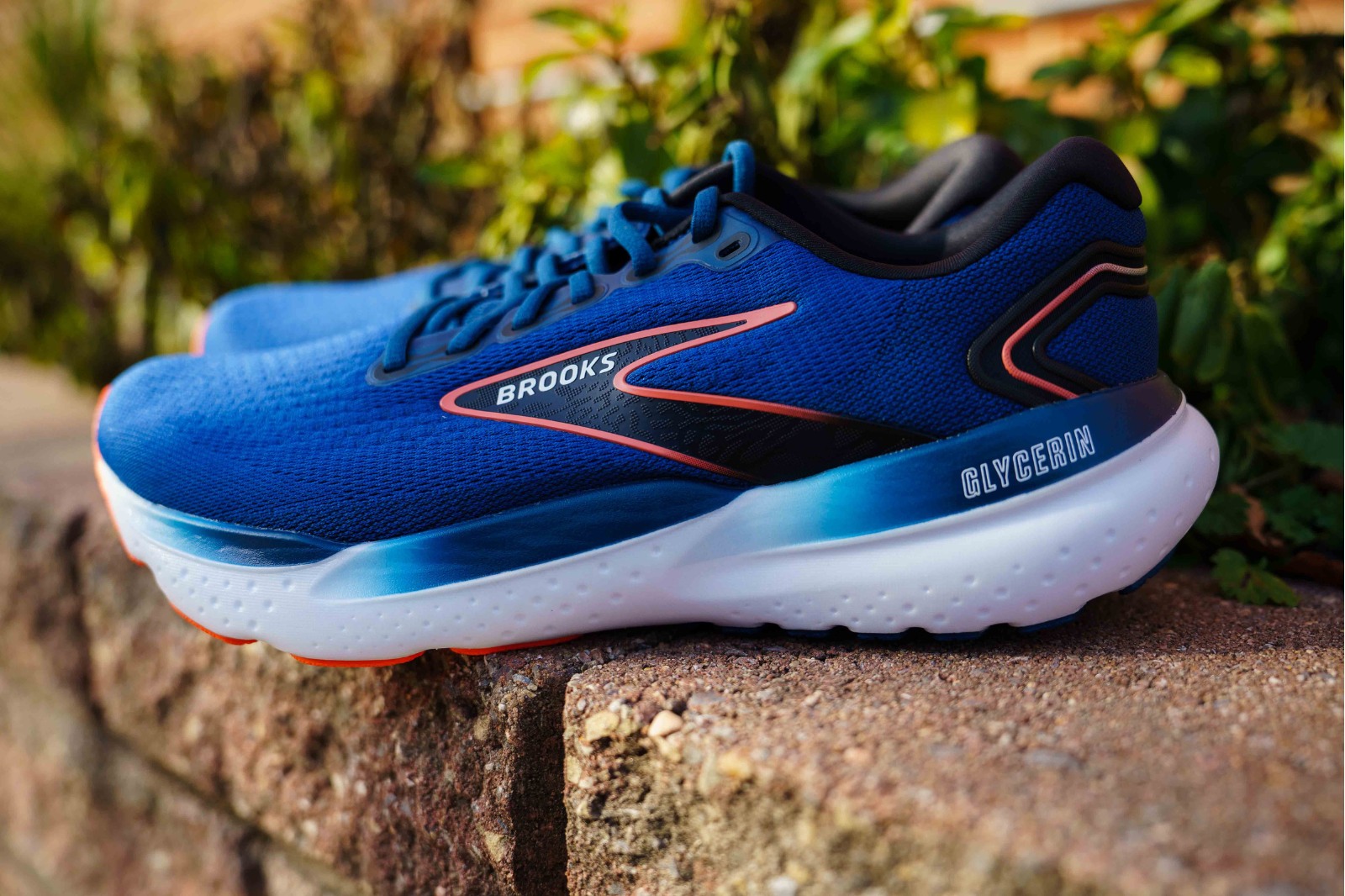
I have to imagine being based in Maryland you all are familiar with and have probably run JFK50. I’m attempting to train up here in Florida to give that a try in 2025…if I didn’t want to have to do a shoe change coming off the AT onto the C&O and final road sections, would this be a good “do-it-all” choice for that course?
John knows the JFK 50 very well, so take his advice. Based off that, I would say you should definitely consider the Adidas Terrex Agravic Speed Ultra coming in April.
Ben
I’ve ran JFK 3 times. Personally I just use road shoes or an extremely lightweight trail shoe that I can use on the trail, road, and towpath that doesn’t make me want to jump in the water.
It all depends on goals though I definitely think you could use the Caldera 7 for the entire race but if you aspire to run the race fast I definitely would go with a road shoe or lighter weight trail shoe.
JFK is an interesting race because you cover multiple surfaces. My best advice is try different shoes out on trail, road, and towpath in Florida and what feels best for you and gives you the best confidence to make the time goal you seek go with it.
I’ve worn trail shoes the entire race before and I’ve worn carbon plated shoes.
Also don’t forget to hit those bridges for vert out there 😁.
I was in Hollywood Florida during the summer and stayed doing bridge work 😆
I’ll be at JFK also hope to see you out there 💪
Thanks for the feedback! And yes, hill repeats up Sugarloaf Mountain (https://en.wikipedia.org/wiki/Sugarloaf_Mountain_(Florida)) will definitely be in my training plan. 🙂 I have family in Hagerstown so have previously run the towpath from the Williamsport trailhead, as well as the AT around Annapolis Rock, both in road shoes without much issue, so as long as the rest of the AT section is about the same technically I suspect that’s what I’ll go with.